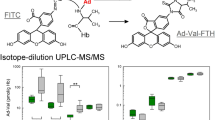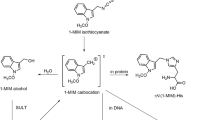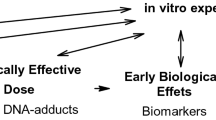Abstract
Furfuryl alcohol is a common food contaminant, which is formed by acid- and heat-catalyzed degradation of fructose and glucose. Its carcinogenic effect in rodents originates most likely from sulfotransferase (SULT)-catalyzed conversion into the mutagenic sulfate ester 2-sulfoxymethylfuran. In this study, a protein adduct biomarker was sought for the medium-term internal exposure to furfuryl alcohol. A UPLC–MS/MS screening showed that the adduct N-((furan-2-yl)methyl)-Val (FFA-Val) at the N-terminus of hemoglobin is a valid target analyte. The Val cleavage by fluorescein isothiocyanate-mediated Edman degradation yielded 3-fluorescein-1-(furan-2-ylmethyl)-5-(propan-2-yl)-2-thioxoimidazolidin-4-one (FFA-Val-FTH), which was characterized by 1H and 13C NMR spectroscopy. An isotope-dilution method for the quantification of FFA-Val-FTH by UPLC–MS/MS was developed. It was used to study the adduct formation in furfuryl alcohol-treated FVB/N mice and the influence of ethanol and the alcohol dehydrogenase (ADH) inhibitor 4-methylpyrazole on the adduct levels. The administration of 400 mg/kg body weight furfuryl alcohol alone led to 12.5 and 36.7 pmol FFA-Val/g Hb in blood samples of male and female animals, respectively. The co-administration of 1.6 g ethanol/kg body weight increased FFA-Val levels by 1.4-fold in males and by 1.5-fold in females. The co-administration of 100 mg 4-methylpyrazole/kg body weight had a similar effect on the adduct levels. A high correlation was observed between adduct levels in hemoglobin and in hepatic DNA samples determined in the same animal experiment. This indicated that FFA-Val is a valid biomarker for the internal exposure to 2-sulfoxymethylfuran, which may be suitable to monitor furfuryl alcohol exposure also in humans.






Similar content being viewed by others
References
Ahman M, Alexandersson R, Ekholm U, Bergstrom B, Dahlqvist M, Ulfvarson U (1991) Impeded lung function in moulders and coremakers handling furan resin sand. Int Arch Occup Environ Health 63:175–180
Alnouti Y, Klaassen CD (2006) Tissue distribution and ontogeny of sulfotransferase enzymes in mice. Toxicol Sci 93:242–255
Barknowitz G, Engst W, Schmidt S et al (2014) Identification and quantification of protein adducts formed by metabolites of 1-methoxy-3-indolylmethyl glucosinolate in vitro and in mouse models. Chem Res Toxicol 27:188–199
Bendadani C, Meinl W, Monien B et al (2014) Determination of sulfotransferase forms involved in the metabolic activation of the genotoxicant 1-hydroxymethylpyrene using bacterially expressed enzymes and genetically modified mouse models. Chem Res Toxicol 27:1060–1069
Buttery RG, Orts WJ, Takeoka GR, Nam Y (1999) Volatile flavor components of rice cakes. J Agric Food Chem 47:4353–4356
De Simon BF, Cadahia E, Jalocha J (2003) Volatile compounds in a spanish red wine aged in barrels made of Spanish, French, and American oak wood. J Agric Food Chem 51:7671–7678
European Food Safety Authority (2009) Consideration of furfuryl alcohol and related flavouring substances evaluated by JECFA (55th meeting) structurally related to furfuryl and furan derivatives with and without additional side chain substituents and heteroatoms. EFSA J 752:1–39
Fernando RC, Schmeiser HH, Scherf HR, Wiessler M (1993) Formation and persistence of specific purine DNA adducts by 32P-postlabelling in target and non-target organs of rats treated with aristolochic acid I. IARC Sci Publ 124:167–171
Hebbring SJ, Adjei AA, Baer JL et al (2007) Human SULT1A1 gene: copy number differences and functional implications. Hum Mol Genet 16:463–470
Honma W, Kamiyama Y, Yoshinari K et al (2001) Enzymatic characterization and interspecies difference of phenol sulfotransferases, ST1A forms. Drug Metab Dispos 29:274–281
IARC (2010) Alcohol consumption and ethyl carbamate. IARC Monogr Eval Carcinog Risks Hum 96:3
International Agency for Research on Cancer (2008) World cancer report 2008. In: Boyle P, Levin B (eds). International Agency for Research on Cancer, Lyon (France), p 471
Karagul-Yuceer Y, Cadwallader KR, Drake M (2002) Volatile flavor components of stored nonfat dry milk. J Agric Food Chem 50:305–312
Landin HH, Tareke E, Rydberg P, Olsson U, Tornqvist M (2000) Heating of food and haemoglobin adducts from carcinogens: possible precursor role of glycidol. Food Chem Toxicol 38:963–969
McCoy LF, Scholl PF, Schleicher RL, Groopman JD, Powers CD, Pfeiffer CM (2005) Analysis of aflatoxin B1-lysine adduct in serum using isotope-dilution liquid chromatography/tandem mass spectrometry. Rapid Commun Mass Spectrom 19:2203–2210
Monien BH (2014) Mass spectrometric DNA adduct quantification by multiple reaction monitoring and its future use for the molecular epidemiology of cancer. Adv Exp Med Biol 806:383–397
Monien BH, Herrmann K, Florian S, Glatt HR (2011) Metabolic activation of furfuryl alcohol: formation of 2-methylfuranyl DNA adducts in Salmonella typhimurium strains expressing human sulfotransferase 1A1 and in FVB/N mice. Carcinogenesis 32:1533–1539
Monien BH, Schumacher F, Herrmann K, Glatt H, Turesky RJ, Chesne C (2015) Simultaneous detection of multiple DNA adducts in human lung samples by isotope-dilution UPLC–MS/MS. Anal Chem 87:641–648
Murkovic M, Swasti YR (2013) 5-Hydroxymethyl-furfural and furfuryl alcohol: occurrence, exposure and detection. In: Pedreschi Plasencia F, Ciesarova Z (eds) Chemical food safety and health. food science and technology. Nova Publishers Inc, New York, pp 43–55
National Toxicology Program (1999) Toxicology and carcinogenesis studies of furfuryl alcohol (CAS No. 98-00-0) in F344/N rats and B6C3F1 mice (inhalation studies). Natl Toxicol Program Tech Rep Ser 482:1–248
Nilsson A, Lagesson V, Bornehag CG, Sundell J, Tagesson C (2005) Quantitative determination of volatile organic compounds in indoor dust using gas chromatography-UV spectrometry. Environ Int 31:1141–1148
Olesen PT, Olsen A, Frandsen H, Frederiksen K, Overvad K, Tjonneland A (2008) Acrylamide exposure and incidence of breast cancer among postmenopausal women in the Danish diet, cancer and health study. Int J Cancer 122:2094–2100
Osaki F, Goto T, Lee SH, Oe T (2014) Predicted multiple selected reaction monitoring to screen activated drug-mediated modifications on human serum albumin. Anal Biochem 449:59–67
Peng L, Turesky RJ (2014) Optimizing proteolytic digestion conditions for the analysis of serum albumin adducts of 2-amino-1-methyl-6-phenylimidazo[4,5-b]pyridine, a potential human carcinogen formed in cooked meat. J Proteomics 103:267–278
Perez-Palacios T, Petisca C, Henriques R, Ferreira IM (2013) Impact of cooking and handling conditions on furanic compounds in breaded fish products. Food Chem Toxicol 55:222–228
Rappaport SM, Li H, Grigoryan H, Funk WE, Williams ER (2012) Adductomics: characterizing exposures to reactive electrophiles. Toxicol Lett 213:83–90
Rietjens SJ, de Lange DW, Meulenbelt J (2014) Ethylene glycol or methanol intoxication: which antidote should be used, fomepizole or ethanol? Neth J Med 72:73–79
Sachse B, Meinl W, Glatt H, Monien BH (2014) The effect of knockout of sulfotransferases 1a1 and 1d1 and of transgenic human sulfotransferases 1A1/1A2 on the formation of DNA Adducts from furfuryl alcohol in mouse models. Carcinogenesis 35:2339–2345
Sachse B, Meinl W, Glatt H, Monien BH (2016a) Conversion of suspected food carcinogen 5-hydroxymethylfurfural by sulfotransferases and aldehyde dehydrogenases in postmitochondrial tissue preparations of humans, mice, and rats. Toxicol Sci 149:192–201
Sachse B, Meinl W, Glatt H, Monien BH (2016b) Ethanol and 4-methylpyrazole increase DNA adduct formation of furfuryl alcohol in FVB/N wild-type mice and in mice expressing human sulfotransferases 1A1/1A2. Carcinogenesis 37:314–319
Sachse B, Meinl W, Sommer Y, Glatt H, Seidel A, Monien BH (2016c) Bioactivation of food genotoxicants 5-hydroxymethylfurfural and furfuryl alcohol by sulfotransferases from human, mouse and rat: a comparative study. Arch Toxicol 90:137–148
Sakuma H, Kusama M, Yamaguchi K, Sugawara S (1984) The distribution of cigarette smoke components between mainstream and sidestream smoke: III. Middle and higher boiling components. Contrib Tob Res 12:251–258
Schubert J, Bewersdorff J, Luch A, Schulz TG (2012) Waterpipe smoke: a considerable source of human exposure against furanic compounds. Anal Chim Acta 709:105–112
Singh R, Gaskell M, Le Pla RC et al (2006) Detection and quantitation of benzo[a]pyrene-derived DNA adducts in mouse liver by liquid chromatography-tandem mass spectrometry: comparison with 32P-postlabeling. Chem Res Toxicol 19:868–878
Tareke E, Rydberg P, Karlsson P, Eriksson S, Tornqvist M (2000) Acrylamide: a cooking carcinogen? Chem Res Toxicol 13:517–522
Törnqvist M, Fred C, Haglund J, Helleberg H, Paulsson B, Rydberg P (2002) Protein adducts: quantitative and qualitative aspects of their formation, analysis and applications. J Chromatogr B Analyt Technol Biomed Life Sci 778:279–308
Umemoto A, Monden Y, Grivas S, Yamashita K, Sugimura T (1992) Determination of human exposure to the dietary carcinogen 3-amino-1, 4-dimethyl-5H-pyrido[4,3-b]indole (Trp-P-1) from hemoglobin adduct: the relationship to DNA adducts. Carcinogenesis 13:1025–1030
Van Putten LM (1958) The life span of red cells in the rat and the mouse as determined by labeling with DFP32 in vivo. Blood 13:789–794
Vázquez-Araújo L, Enguix L, Verdú A, García-García E, Carbonell-Barrachina AA (2008) Investigation of aromatic compounds in toasted almonds used for the manufacture of turron. Eur Food Res Technol 227:243–254
von Stedingk H, Rydberg P, Törnqvist M (2010) A new modified Edman procedure for analysis of N-terminal valine adducts in hemoglobin by LC–MS/MS. J Chromatogr B Anal Technol Biomed Life Sci 878:2483–2490
Westberg EA, Singh R, Hedebrant U et al (2014) Adduct levels from benzo[a]pyrenediol epoxide: relative formation to histidine in serum albumin and to deoxyguanosine in DNA in vitro and in vivo in mice measured by LC/MS-MS methods. Toxicol Lett 232:28–36
Wilson KM, Balter K, Adami HO et al (2009) Acrylamide exposure measured by food frequency questionnaire and hemoglobin adduct levels and prostate cancer risk in the cancer of the prostate in Sweden study. Int J Cancer 124:2384–2390
World Cancer Research Fund/American Institute for Cancer Research (2007) food, nutrition, physical activity, and the prevention of cancer: a global perspective. AICR, Washington, DC, pp 1–537
Xia Q, Zhao Y, Lin G, Beland FA, Cai L, Fu PP (2016) Pyrrolizidine alkaloid-protein adducts: potential non-invasive biomarkers of pyrrolizidine alkaloid-induced liver toxicity and exposure. Chem Res Toxicol 29:1282–1292
Xie J, Terry KL, Poole EM et al (2013) Acrylamide hemoglobin adduct levels and ovarian cancer risk: a nested case-control study. Cancer Epidemiol Biomark Prev 22:653–660
Zhu L, Xue J, Xia Q, Fu PP, Lin G (2016) The long persistence of pyrrolizidine alkaloid-derived DNA adducts in vivo: kinetic study following single and multiple exposures in male ICR mice. Arch Toxicol. doi:10.1007/s00204-016-1713-z
Acknowledgements
The authors gratefully acknowledge financial support from the German Research Foundation (MO 2520/1-1) and the German Institute of Human Nutrition (DIfE). Further, the authors thank Elke Thom for their excellent technical assistance.
Author information
Authors and Affiliations
Corresponding author
Ethics declarations
Conflict of interest
The authors declare that they have no conflicts of interest.
Electronic supplementary material
Below is the link to the electronic supplementary material.
Rights and permissions
About this article
Cite this article
Sachse, B., Hielscher, J., Lampen, A. et al. A hemoglobin adduct as a biomarker for the internal exposure to the rodent carcinogen furfuryl alcohol. Arch Toxicol 91, 3843–3855 (2017). https://doi.org/10.1007/s00204-017-2005-y
Received:
Accepted:
Published:
Issue Date:
DOI: https://doi.org/10.1007/s00204-017-2005-y




